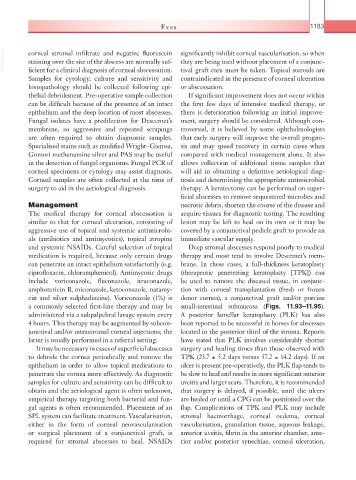Page 1208 - Equine Clinical Medicine, Surgery and Reproduction, 2nd Edition
P. 1208
Eyes 1183
VetBooks.ir corneal stromal infiltrate and negative fluorescein significantly inhibit corneal vascularisation, so when
they are being used without placement of a conjunc-
staining over the site of the abscess are normally suf-
ficient for a clinical diagnosis of corneal abscessation.
contraindicated in the presence of corneal ulceration
Samples for cytology, culture and sensitivity and tival graft care must be taken. Topical steroids are
histopathology should be collected following epi- or abscessation.
thelial debridement. Pre-operative sample collection If significant improvement does not occur within
can be difficult because of the presence of an intact the first few days of intensive medical therapy, or
epithelium and the deep location of most abscesses. there is deterioration following an initial improve-
Fungal isolates have a predilection for Descemet’s ment, surgery should be considered. Although con-
membrane, so aggressive and repeated scrapings troversial, it is believed by some ophthalmologists
are often required to obtain diagnostic samples. that early surgery will improve the overall progno-
Specialised stains such as modified Wright–Giemsa, sis and may speed recovery in certain cases when
Gomori methenamine silver and PAS may be useful compared with medical management alone. It also
in the detection of fungal organisms. Fungal PCR of allows collection of additional tissue samples that
corneal specimens or cytology may assist diagnosis. will aid in obtaining a definitive aetiological diag-
Corneal samples are often collected at the time of nosis and determining the appropriate antimicrobial
surgery to aid in the aetiological diagnosis. therapy. A keratectomy can be performed on super-
ficial abscesses to remove sequestered microbes and
Management necrotic debris, shorten the course of the disease and
The medical therapy for corneal abscessation is acquire tissues for diagnostic testing. The resulting
similar to that for corneal ulceration, consisting of lesion may be left to heal on its own or it may be
aggressive use of topical and systemic antimicrobi- covered by a conjunctival pedicle graft to provide an
als (antibiotics and antimycotics), topical atropine immediate vascular supply.
and systemic NSAIDs. Careful selection of topical Deep stromal abscesses respond poorly to medical
medication is required, because only certain drugs therapy and most tend to involve Descemet’s mem-
can penetrate an intact epithelium satisfactorily (e.g. brane. In these cases, a full-thickness keratoplasty
ciprofloxacin, chloramphenicol). Antimycotic drugs (therapeutic penetrating keratoplasty [TPK]) can
include voriconazole, fluconazole, itraconazole, be used to remove the diseased tissue, in conjunc-
amphotericin B, miconazole, ketoconazole, natamy- tion with corneal transplantation (fresh or frozen
cin and silver sulphadiazine). Voriconazole (1%) is donor cornea), a conjunctival graft and/or porcine
a commonly selected first-line therapy and may be small-intestinal submucosa (Figs. 11.93–11.95).
administered via a subpalpebral lavage system every A posterior lamellar keratoplasty (PLK) has also
4 hours. This therapy may be augmented by subcon- been reported to be successful in horses for abscesses
junctival and/or intrastromal corneal injections; the located in the posterior third of the stroma. Reports
latter is usually performed in a referral setting. have stated that PLK involves considerably shorter
It may be necessary in cases of superficial abscesses surgery and healing times than those observed with
to debride the cornea periodically and remove the TPK (23.7 ± 5.2 days versus 57.2 ± 14.2 days). If an
epithelium in order to allow topical medications to ulcer is present pre-operatively, the PLK flap tends to
penetrate the cornea more effectively. As diagnostic be slow to heal and results in more significant anterior
samples for culture and sensitivity can be difficult to uveitis and larger scars. Therefore, it is recommended
obtain and the aetiological agent is often unknown, that surgery is delayed, if possible, until the ulcers
empirical therapy targeting both bacterial and fun- are healed or until a CPG can be positioned over the
gal agents is often recommended. Placement of an flap. Complications of TPK and PLK may include
SPL system can facilitate treatment. Vascularisation, stromal haemorrhage, corneal oedema, corneal
either in the form of corneal neovascularisation vascularisation, granulation tissue, aqueous leakage,
or surgical placement of a conjunctival graft, is anterior uveitis, fibrin in the anterior chamber, ante-
required for stromal abscesses to heal. NSAIDs rior and/or posterior synechiae, corneal ulceration,

